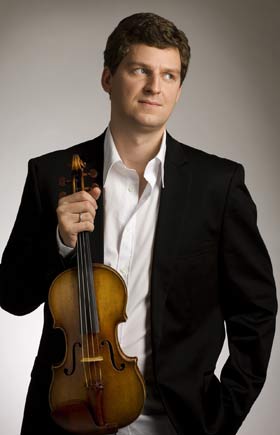 Canadian violinist James Ehnes.
Canadian violinist James Ehnes. Of course, Ehnes was a prodigy, and his exceptional musical gifts were duly noted and cultivated when he was a child. Also, he did win a few competitions in his early years. But these things were never made into launching-pads for a “meteoric” career. Rather, his rise to international prominence has been steady and methodical – more about stamina than speed, and more about artistry than sensationalism.
He turned 40 earlier this year, an age when classical musicians are no longer considered young, and are expected to don the mantle of maturity. But Ehnes has been a mature musician for many years. Every time I’ve heard him perform – and I’ve heard him a number of times over the last two decades – he has played with intelligence, sensitivity and sincerity.
This concerto is clearly dear to his heart. (He recorded it with the Philharmonia Orchestra about 10 years ago, and you can find a YouTube video of him playing it with the WDR Orchestra, here.) Alas, honesty compels me to admit that I don’t entirely share his fondness for the piece: I hear it as cloyingly voluminous and voluptuous, with a little too much “muchness,” for my taste. However, there’s no denying it’s a work only an accomplished master could play well.
Ehnes’s performance was infused with warmth and elegance. Phrases were spun out in long arcs, full of shifting colours and dynamics, and tricky double-stopped passages were played with facility. As well, there were moments of dramatic intensity, and other passages that brightly sparkled. But there was nothing meretricious about any of it: true to his signature style, every note and phrase was musically purposeful.
From the podium, TSO music director Peter Oundjian emphasized the fluidity of Elgar’s score, giving the piece an unsettled energy. Throughout, he and Ehnes engaged in a subtle back-and-forth dialogue. Yet both were mindful of balance, and the soloist’s 1715 Strad soared above the band.
It’s hard to believe that Elgar’s concerto was composed three years before the other major work on the program, Stravinsky’s Rite of Spring. The contrast was vivid.
This was the third time in the last four years that I’ve heard the TSO play Stravinsky’s scandalous ballet of 1913. Indeed, the Rite seems to have become a kind of “party piece” for the orchestra, and the TSO’s loving relationship with this music was entirely apparent on Friday night. Every section dug into the score with enthusiasm: the brass was bold and edgy, the woodwinds were starkly bright, the strings were thick and dark, and the percussion section was absolutely ferocious.
Yet I do not say “unbridled” enthusiasm, because it was all effectively controlled by Oundjian's elbow-jabs and karate-chops. I can’t say that I agree with all aspects of his interpretation: for one thing, I felt that his tempo for “Rondes Printanières” was too brisk. But there’s no one single way to do the Rite – Stravinsky himself recorded it five different ways – and that’s part of the multifaceted magic of the piece.
Here's an idea: Maybe the TSO should make The Rite of Spring an annual event, like Handel’s Messiah. (Curiously, both works share the common theme of human sacrifice for religious purposes.)
There was one other work performed, at the outset of the concert: Anton Webern’s Five Pieces for Orchestra. These sparse, pontillistic miniatures were once skewered by the critic Lawrence Gilman with the phrase “the amoeba weeps.” But on this occasion, the amoeba didn’t weep: Oundjian’s reading was more clinical than expressive.
© Colin Eatock 2016
 RSS Feed
RSS Feed

